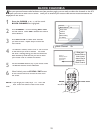
31
GLOSSARY
4:3
4:3 is an aspect ratio of traditional squarish National Television Systems Committe (NTSC) TV screens; it stands for four
units of width for every three units of height.
Aspect Ratio
The ratio between the width and height of the TV picture on the screen. In a normal TV set the aspect ratio is 4
to 3 (4:3).
Audio Video (A/V)
A term often used when discussing a channel on a TV receiver or on video equipment, which has been
especially designed to accept VCR audio-video signals. This channel automatically activates special circuitry
within the TV set to prevent picture distortion and skewing. It is also used for audio-video processors, which
handle both types of signals.
Cable Converter Box
A device that allows your television to receive the expanded number of channels provided by broadcasters. Some of these
programs provided by the broadcast may not be free, you’ll have to pay to view them.
Coaxial Cable
Coaxial cable is a copper cable used to connect cable signal coming from Cable TV Company to the TV.
Composit Video Input
Connection
An analog encoded video signal that includes vertical and horizontal synchronizing information. Since both luminance
(brightness) and chrominance (color) signals are encoded together, only a signal connection wire is needed. A composite
video jack is usually a single RCA-type.
Component Video
Input Connection
Provides the highest possible color and picture resolution on the playback of digital signal source material like DVD players.
The color difference signals (Pb, Pr) and the luminance(Y) signals are connected separately which allows for improved
color bandwidth information (not possible when using composite video or S-Video connections).
Letterbox
Letterbox refers to the image of a wide-screen picture on a standard 4:3 aspect ratio television screen.
Luminance
The brightness or black-and-white component of a color video signal. Determines the level of picture detail.
NTSC
National television system committee. The organization that developed the analog television standard currently in use in the
U.S., Canada, and Japan. Now generally used to refer to that standard. The NTSC standard combines blue, red, and green
signals modulated as an AM signal with an FM signal for audio.
S-Video
Separated
video.
An encoded video s
ignal which separates the brightness from color data. S-Video can greatly improve
the picture when conne
cting TV
s to any high quality video s
ource such as digital broadcast satellite (DBS) and DV
Ds.
WARNING
Concerning Stationary Images on the TV Screen:
Do not leave stationary or letterbox images on screen for
extended periods of time. This can cause uneven picture-tube
aging.
Normal use of the TV should involve the showing of pictures
that contain constantly moving and changing images that fill the
screen. Be careful not to leave nonmoving images on screen
for extended periods of time, or to display the same images
on screen too frequently, because subtle ghost images can be
left on the picture tubes. Sources of stationary images may be
DVD disks, laser disks, video games, CD-i disks, videotapes,
digital television boxes, broadcast channels, cable channels, sat-
ellite channels, and others. Here are some examples of station-
ary images (this is not an all-inclusive list; you may encounter
others in your viewing):
• DVD menus—listings of DVD disk content
• Letterbox black bars—shown at the top and bottom of the
TV screen when a wide screen (16:9) movie is viewed on a
TV with standard (4:3) aspect ratio.
• Video-game images and scoreboards
• Television station logos—present a problem if they are
bright and stationary; moving or low-contrast graphics are
less likely to cause uneven aging of the picture tube
• Stock-market tickers—presented at the bottom of the TV
screen
• Shopping channel logos and pricing displays—bright and
shown constantly or repeatedly in the same location on the
TV screen.
Placement of the TV
• To avoid cabinet warping, cabinet color changes, and
increased chance of set failure, do not place the TV where
temperatures can become excessively hot; for example, in
direct sunlight or near a heating appliance.
• Be sure to allow a free flow of air to and from the perfo-
rated back cover of the set.
Cleaning
• To avoid possible shock hazard, be sure the TV is unplugged
from the electrical outlet before cleaning.
• Regularly dust the TV with a dry, nonscratching duster to
keep the TV clean.
• When cleaning the TV, take care not to scratch or damage
the screen surface. Avoid wearing jewelry or using anything
abrasive. Do not use household cleaners. Wipe the front
screen with a clean cloth dampened with water. Use even,
easy, vertical strokes when cleaning.
• Gently wipe the cabinet surfaces with a clean cloth or
sponge dampened in a solution of cool, clear water and a
mild soap or detergent. Use a clean, dry cloth to dry the
wiped surfaces.
• Occasionally vacuum the ventilation holes or slots in the
back cover of the set.
• Never use thinners, insecticide sprays, or other chemicals on
or near the cabinet, as they might cause permanent damage
of the cabinet finish.
CLEANING AND CARE


















